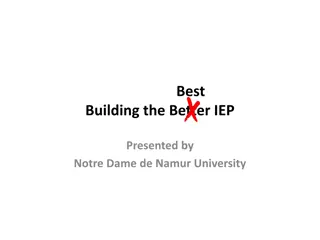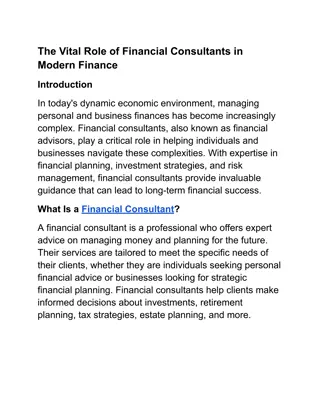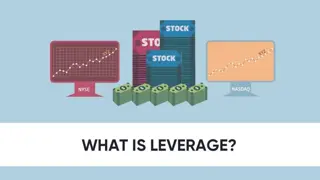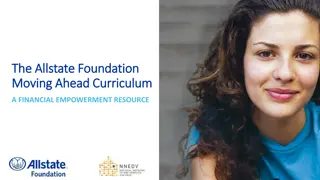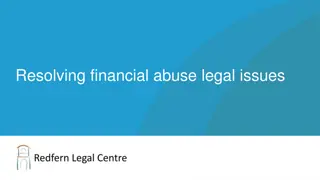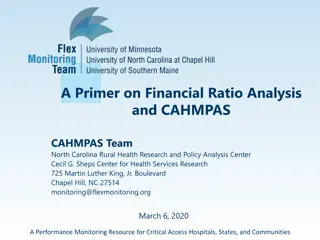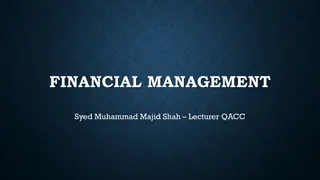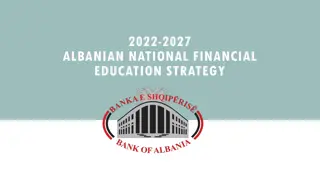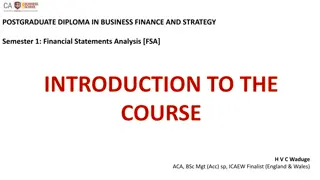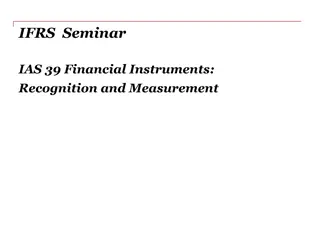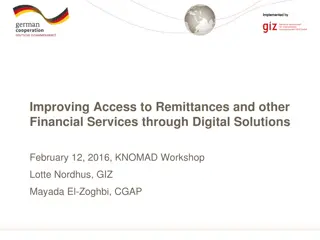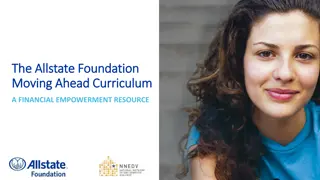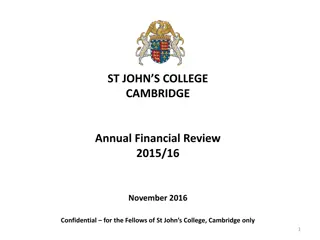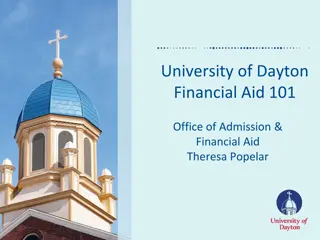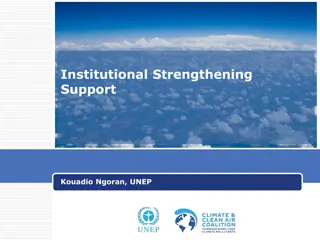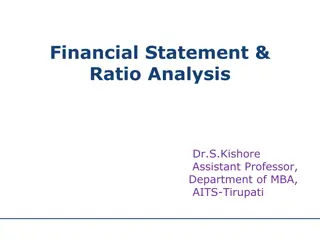National Financial Education Strategies and Best Practices
Financial education plays a crucial role in empowering individuals and ensuring financial system stability globally. The National Strategies for Financial Education (NFES) endorsed by the G20 have been adopted by approximately 100 countries. Different approaches such as stand-alone strategies, multi-institutional approaches, and interagency committees are utilized to develop NFES. Leadership and coordination of NFES vary among entities like ministries of finance, central banks, and multi-stakeholder groups. Financial education mandates and roles of stakeholders are essential for successful implementation. Despite its challenges, financial education remains a key component for financial empowerment.
Download Presentation

Please find below an Image/Link to download the presentation.
The content on the website is provided AS IS for your information and personal use only. It may not be sold, licensed, or shared on other websites without obtaining consent from the author.If you encounter any issues during the download, it is possible that the publisher has removed the file from their server.
You are allowed to download the files provided on this website for personal or commercial use, subject to the condition that they are used lawfully. All files are the property of their respective owners.
The content on the website is provided AS IS for your information and personal use only. It may not be sold, licensed, or shared on other websites without obtaining consent from the author.
E N D
Presentation Transcript
National Financial Education Strategies National Financial Education Strategies Best practices and next steps Edlira Dashi Financial Sector Specialist
National Financial Education Strategies Financial education is a core component of financial empowerment for individuals and the stability of the financial system In 2016, the leaders of the G20 endorsed the National Strategies for Financial Education (NFES), developed by the OECD and International Gateway for Financial Education. Roughly 100 countries have adopted or are actively drafting a NFES. The World Bank has provided inputs to the Bank of Albania on the NFES development in the context of the Remittances and Payments Program, funded by SECO.
Many Different Approaches A SINGLE INSTITUTION STAND-ALONE STRATEGY (most common) leads the strategy drafting process, as well as the overall coordination, monitoring and evaluation. This can be done with the help of donors, working groups and broader consultations to solicit other stakeholder inputs This is a strategy that outlines steps, roles and responsibilities for the design, implementation and evaluation of a National Financial Education Strategy (NFES). A MULTI-INSTITUTIONAL APPROACH HYBRID OR INTEGRATED STRATEGY where multiple institutions may share accountability and draft the NFES together (either with or without support of a donor or third-party consultant). WGs and broader stakeholder consultations still apply. Financial education is often a pillar or key component or objective of a country s National Financial Inclusion Strategy (NFIS) or any relevant national strategy. INTERAGENCY COMMITTEE STAND-ALONE PROGRAM is constituted under the leadership of a single institution but tasked to design, develop and launch an NFES. This approach is generally implemented in countries where regulatory authority is dispersed across multiple institutions within the financial sector This is often a precursor of a NFES. It might outline an approach for reaching various target groups but does not contain other components such as a coordinating body or monitoring and evaluation (M&E) system. 3
NFES Leadership & Coordination Ministry of Finance or other ministry is lead entity in 40% Other financial sector regulatory authority is lead entity in 3% Central Bank is lead entity in 37% A multi-stakeholder entity leads in 20% (e.g., Mexico, Kyrgyz Republic) (e.g., Nigeria, Pakistan) (e.g., Peru, Indonesia) (e.g., S. Korea)
Financial Education Mandates
Illustrative Roles of Stakeholders
Financial Education is a challenging undertaking Cumbersome data collection Broad scope Resource-intensive High cost
Building blocks of an effective NFES Assessment Governance & Coordination Programmatic scope Management Strong central leadership body Balance between inclusive and efficient governance structure Strong buy-in from start High-level champions within each implementing institution Partnerships: private, public, NGO Mapping of existing initiatives Robust diagnostics and data to provide analytical foundation National financial capability survey for benchmarking Programs built on good practices Well-defined action plan Clear, concrete, prioritized objective Prioritization to focus on high-priority, high-impact actions Focus on digital approaches, including flexibility to adapt action plan to reflect market developments Quick wins to build momentum following launch Roadmap and ideas for funding Mobilization of resources for implementation prior to launch Effective communication / branding of the NFES Well-resourced and robust monitoring and evaluation system
Key pillars of developing institutional action plans
STEP 1: Assess the Landscape Gather insights from related stakeholders, such as market conduct and consumer- protection supervisors, Focus on points of interaction between consumers, FSPs, and government financial programs Take stock of best practices 1 2 3 Leverage various data collection means (desk research, customer journey mapping, consumer profiling, stakeholder interviews, phone surveys, etc.) Gather the perspectives of the various stakeholders 4
STEP 2: Identify and Prioritize Areas of Consumer Risk 1 2 3 4 Identify immediate needs from the perspective of different types of consumers as well as core gaps across different product lines during key interactions between consumers and their FSPs or financial programs. Detect emerging areas of consumer risks that warrant priority as well as core education gaps and needs of different consumer profiles. Identify opportunity areas where core financial education messages can be integrated to help consumers navigate their financial lives. Prioritize based on assessing trade-offs between lower- hanging fruits, their capacity and resources, and existing consumer risks with greatest implications on inclusion/stability.
STEP 3: Build an Effective Framework 1 2 3 4 Partner with key institutions to embed financial education into existing financial programs. Provide guidance to regulated entities. Offer financial education tools to the public. Develop a cross- cutting monitoring and evaluation (M&E) framework.
Leverage behavioral design LEVERAGE TEACHABLE MOMENTS REINFORCE MESSAGES USE NUDGES AUTOMATION MAKE IT FUN AND ENTERTAINING
Address the Needs of Women and Vulnerable Populations Ensure that women and other minorities are well represented in key leadership and decision- making roles across the financial education space. Encourage FSPs to hire with more intentionality a representative staff, including more female and minority staff and female and minority management. Ensure that consumer voices are well heard, including the voice of associations that work to represent women or minorities specifically. To inform programmatic design, collect adequate data to understand different profiles of consumers and their needs. Avoid referring in content and training to gendered behaviors or stereotypes that affect marginalized consumers, as otherwise it may reinforce false perceptions of different population groups. Advocate for and include scenarios in which women or other marginalized consumers take active roles in financial management and decision- making. Identify optimal times for training that work better with the schedules of women or other vulnerable consumers. Include representatives from all target groups in consultations and training staff.
Know your target groups FINANCIAL EDUCATION SHOULD BE CLIENT FOCUSED AND REFLECT THE DEMOGRAPHICS, CULTURAL AND FINANCIAL CONTEXT, AND LEARNING NEEDS AND PREFERENCES OF THE TARGET POPULATION. EDUCATION MUST BE RELEVANT IN THE CONTEXT OF CONSUMERS FINANCIAL LIVES AND HELP INFORM THEM ABOUT FINANCIAL DECISIONS THAT CAN BE REALIZED IN THE SHORT OR MEDIUM TERM. ASSESSMENT CAN BE CONDUCTED THROUGH A VARIETY OF MEANS, TO SHED LIGHT ON BOTH KEY FINANCIAL EDUCATION GAPS IN THE MARKET AND OPPORTUNITIES WHERE ADDITIONAL EDUCATION AND INFORMATION CAN BE EMBEDDED TO ADDRESS THESE GAPS.
Use a Wide Range of Tools and Channels NONTRADITIONAL CHANNELS (THAT IS, CHATBOTS, SMS MESSAGES, TABLETS, PHONE APPLICATIONS, AND SO FORTH). KEY MESSAGES AND SIMULATIONS MAY BE USEFUL DURING PROGRAM ONBOARDING, WHILE NUDGES VIA SMS AND DEFAULT SAVINGS OPTIONS MAY ENCOURAGE CUSTOMERS TO USE OR SAVE AS PART OF THE PROGRAM. A VARIETY OF CHANNELS AND DELIVERY PLATFORMS SUCH AS NUDGES, REMINDERS, AND CHOICE ARCHITECTURE. BIG DATA CAN BE LEVERAGED TO PROVIDE CUSTOMER SUPPORT AND EDUCATION BY, FOR INSTANCE, HELPING CUSTOMERS NAVIGATE INFORMATION- DENSE PRODUCT OFFERINGS OR INCORPORATING ROBO-ADVICE ON HOW TO MEET SAVINGS TARGETS.
Learn by Doing Incorporating simulations helps consumers practice using new technologies and testing key functions. This approach could also be helpful in cases where consumers are not literate enough to read written instructions. Practicing is particularly important for digital finance, as it helps consumers master their financial knowledge and skills and improves their familiarity and confidence when conducting digital transactions. Providing tutorials for innovative products helps build consumer confidence through hands-on learning. This may include offering demonstrations of technology-driven products and delivery channels. Delivering financial education as part of consumers digital- payment product may holistically strengthen their familiarity with digital products and service
Mistakes to avoid Making assumptions on the numeracy and literacy levels of beneficiaries, including conceptual assumptions on understanding of money or savings. Rushing to integrate various delivery channels without assessing the levels of accessibility and feasibility of each channel. Using a single delivery mechanism as opposed to employing a range of channels Using lecture-based curricula which can become boring or unengaging Delivering lessons during times that do not leverage relevant, teachable moments or relate to applicable experiences for the beneficiary. Building one-time lessons or programs, without repeating and reinforcing messages throughout the cash transfer program. Reinventing the wheel and dismissing lessons learned from successful financial education programs already undertaken in the country. Including messages which market initiatives for financial products, services or providers.
SOURCE RESOURCE Good Practices for Financial Consumer Protection Integrating Financial Capability into Government Cash Transfer Programs Financial education Programs and Strategies: Approaches and Available Resources Making Sense of Financial Capability Surveys around the World Financial Capability in Low- and Middle-Income Countries: Measurement and Evaluation Enhancing Financial Capability and Behavior in Low- and Middle-Income Countries Consumer Risks in Fintech New Manifestations of Consumer Risks and Emerging Regulatory Approaches World Bank CGAP88 Elevating the Collective Consumer Voice in Financial Regulation Smarter Financial Education: Key Lessons from Behavioural Insights for Financial Literacy Initiatives The Application of Behavioural Insights to Financial Literacy and Investor Education Programmes and Initiatives National Strategies for Financial Capability: OECD/INFE Policy Handbook OECD/INFE High-Level Principles on National Strategies for Financial Education G20/OECD Core Competencies Framework on Financial Literacy for Adults OECD/INFE Core Competencies Framework on Financial Literacy for Youth OECD/INFE Report on Financial Education in APEC Economies: Policy and Practice in a Digital World OECD/INFE Key Resources Microfinance Opportunities Taking Stock: Financial Education Initiatives for the Poor Center for Financial Inclusion/Accion A Fourth Era: Balancing Behavioral Interventions with Quality Education Seven behaviorally informed practices for effective financial capability interventions Delivering Financial Capability: A Look at Business Approaches A Change in Behavior: Catalogue of Innovations in Financial Capability Innovations for Poverty Action Beyond the Classroom: Evidence on New Directions in Financial Education The Financial Competency Matrix for Adults: A Policy Framework Financial Education in Latin America and the Caribbean AFI Global Toronto Center How Supervisors Can Improve the Effectiveness of Financial Education
Overview Overview of of Rigorous Rigorous Financial Financial Education Education Impact Impact and and Meta Meta- -Analysis: Analysis: SOURCE World Bank RESOURCE Financial Education Programs and Strategies Can You Help Someone Become Financially Capable?: A Meta-Analysis of the Literature Does Financial Education Impact Financial Literacy and Financial Behavior, and If So, When? CFI IPA A Fourth Era: Balancing Behavioral Interventions with Quality Education Beyond the Classroom: Evidence on New Directions in Financial Education Management Science GFLEC Financial Literacy, Financial Education, and Downstream Financial Behaviors Financial Education Affects Financial Knowledge and Downstream Behaviors
What Works in Financial Education
Examples of Financial education platforms REGULATORY AUTHORITY WEB-BASED FINANCIAL EDUCATION TOOLS Australian Securities and Investments Commission The MoneySmart website includes financial education information on topics such as money management, debt reduction, and investments. The site also includes online calculators and tools. United States Consumer Finance Protection Bureau (CFPB) The CFPB s website offers a set of consumer tools, with information on easy-to-recognize terms and topics, such as auto loans, debt collection, credit cards, and bank accounts and services, through which consumers can access practical information needed in that particular teachable moment. The CFPB s website also includes resources for educators to help them develop and deliver financial education content themselves. The resources are categorized for different population segments, such as adults, youth, or vulnerable consumers. United Kingdom s Money Advice Service The Money Advice Service is a website tailored to consumers practical needs and divides information into different money topics in which a consumer might be interested, such as debt and borrowing or cars and travel. Based on the need, a consumer can access a dropdown menu of information and tools that will inform their decision about, for example, buying a car. Banque de France The Banque de France, French Prudential Supervision and Resolution Authority, and Autorit des march s financiers have a joint dedicated website that provides practical information on banking products, insurance, and financial investments; provides guidance to consumers before the completion of a transaction or in case of a complaint; helps the public to protect themselves from scams; provides alerts on unauthorized practices, actors, or websites; and collects information or complaints that customers wish to bring to the attention of the authorities. South African Financial Sector Conduct Authority (FSCA) The FSCA s consumer education department manages a website that presents educational material on topics such as money management, financial protection, and investments. Bank of Italy The Bank of Italy s website provides a series of services to consumers, including access to credit register data and lists of registered financial providers and products. A special portal called Economics for Everyone summarizes the full range of Bank of Italy s financial education programming, including initiatives for children, adults, schools, and universities. The portal provides news, videos, calculators, games, and infographics, among other useful tools for everyday choices, including online purchases, opening a current account, managing the family budget, and applying for a loan. Banco de Portugal The Central Bank of Portugal has been promoting financial awareness and financial education through a series of interventions, including a dedicated website (the Banking Customer Portal) that contains information on all key banking products and services in Portugal and various related resources, such as a glossary of financial terms and answers to frequently asked questions. A special focus of Banco de Portugal s financial education activities has been youth. Central Bank of Bosnia and Herzegovina The Central Bank of Bosnia and Herzegovina developed a financial education web portal that provides content and guidance for consumers and providers. The portal provides in-depth information on key financial services related to capital markets, leasing, and factoring, and the topics were chosen as priority topics to help build consumers knowledge of how these financial services work in practice. Financial Consumer Agency of Canada The Canadian Financial Literacy Database offers tools to help individuals identify areas where they could broaden their financial knowledge and skills (through a self-assessment quiz) and then directs them a database of specific resources or events that can help them improve or maintain their financial skills and knowledge. The resources in the database can be searched by topic, population segment, location, or knowledge level. The database also offers a list of financial-literacy events across the country, funding programs that support financial-literacy initiatives, and published research and reports
Examples of Financial Education Platforms PLATFORM TYPE DESCRIPTION INNOVATIVE PLATFORMS Using mobile platforms to deliver financial capability through (i) SMS messaging and reminder systems; (ii) voice calling and voice- mails; and (iii) application-based programs. JUNTOSuses SMS messaging for reminders and automated conversation based on machine learning technologies to build trust and capability for customers; Banamexuses texts and calls to provide capability elements to beneficiaries. MOBILE-BASED PLATFORMS Leveraging social relationships, key community leaders, or local government authorities to deliver or reinforce key capability messages. Uses informal or formal touch points (like clubs or associations) to provide trainings and trainers. HERfinancec leverages social interactions to pass along trainings and financial information to other women through workplace-based financial education sessions. SOCIAL/ LOCAL CONNECTIONS Using TV shows, posters, radio shows, movies, commercials, comics, and so on to provide financial capability concepts. Nigeria Nollywood Nudge, Makutano Junction, and Scandal all embedded financial capability concepts and themes through videos and soap operas. MASS MEDIA / ENTERTAINMENT CURRICULUM BASED Embedding financial capability and literacy pro- grams into available education modules, curri- culums, or training. Can use, for instance, schools as a platform to deliver workshops or events. BANSEFI Mexico provides face-to-face financial capability trainings provided by core program staff before providing cash transfers to recipients. Embedding financial capability training into tablets or other application- based programs (often self-paced) LISTAd Colombia designed self-paced financial capability modules delivered to CCT recipient villages through tablets. A community organizer provides and rotates the tablets between households, where CCT recipients go through the courses at their own pace. TABLETS / PROGRAMMED APPLICATIONS Mexico s Consumer Protection Agency CONDUSEFdeveloped a government-led financial literacy and transparency website (and magazine) to promote financial capability Use of online or internet-based websites as either (i) freestanding websites for counseling or advice or (ii) complementary tools by providers. ONLINE AND INTERNET BASED
Action Plan Common Country Approaches to Improve Financial Education
Built on solid and wide- ranging research (or needs assessment) Targeted and relevant design and delivery Accessibility of content and delivery Engaging format and interactive delivery (dialogue, media, games, mobile tech, etc.) Development of Programs: Good practices Timely interventions ( teachable moments ) Leverage existing social networks Provide unbiased information on services (not simply marketing ) Incorporate nudges and reinforcement not just a one-off Provide opportunities for learning by doing Cost-effective and scalable Builds in monitoring to ensure quality
Effective Design: Key Considerations for Program Design and Delivery Remain within core mandate Provide financial education during teachable moments Reflect the context of financial services actually available to recipients Cost and resource effective Reinforce education and key messages periodically, through the active engagement of participants over time
Effective Design: Key Considerations for Program Delivery Use a wide range of instruments, particularly for illiterate beneficiaries Build on the existing evidence base of effective programs Simulate and provide demonstrations of the technology or product first, particularly if using tablets, smartphones, or feature phones SMS messaging for core concepts or reminders to those with existing context
Figure One. Best Practice Components of Financial Education Programs: The Design, Development, and Delivery of Education Programs Delivery Models Curriculum Design Program Evaluation Content Development Program Design Identify an appropriate channel or combination of channels to deliver training Select an appropriate org. configuration for program development & delivery Create relevant content to deliver target curriculum elements Identify needs and gaps to needs to design the appropriate curriculum Deliver training programs and evaluate 1. There have been shortcomings in program evaluations 2. Efforts should be systematized for automated reporting and not use self reporting which may be biased 3. Key dimensions to capture in program evaluation include: evaluation of each program component (e.g., curriculum design, program design), attainment of objectives, impact, and behavioral changes 4. Capture innovative dimensions in evaluation to contribute to the body of knowledge on design and delivery approaches 1. Shift in focus to capabilities 2. Determine the scope of capabilities to be targeted for the literacy effort and Identify target behaviors 3. Curriculum design requires establishing a baseline 4. Several instruments are available to establish a capabilities baseline 5. Key to curriculum development and associated content is addressing literacy gaps identified by research instrument 6. Strawman core curriculum for marginalized populations presented in Figure One and remittance recipients in Appendix One 1. Program design should incorporate elements of successful programs 2. Nature of the content being delivered. 3. Several physical and digital channels exist to deliver educational content 4. A number of approaches and practices exist to educate participants and drive behavioral change. 1. Factors impacting the choice of delivery model include: breadth, scale, and geography 2. Additional considerations includes the nature of product deployment, channel selection, and associated funding 3. Gaps in resources and expertise are among the factors influencing the choice to work with other entities 4. The choice of implementor is driven by several considerations 5. FSP are often concerned with program viability: stakeholder business case, revenues, viability and goals attainment 1. Frame content in a manner that resonates with target audience 2. Considerations to address in framing include cultural norms, level of education and target customer agency 3. Review of the customer journey and identify intervention opportunities to guide content framing 4. Adaptations may be required for programs with a focus on digital literacy or addressing adult education
Figure Three: Key Learnings from Best Practices Program Evaluation Delivery Models Content Development Curriculum Design Program Design Create relevant content to deliver target curriculum elements Deliver training programs and evaluate Identify audience needs and associated gaps to design appropriate curriculum Identify the right combination of channels to deliver training Identify business model for delivery of training Leverage research instrument used in capabilities and behavior assessment for insights into how the target population likes to learn Develop a customer journey to inform messaging opportunities & their deliver Incorporate at least one of the successful design elements into program design: simple & actionable, personalized, timely, convenient & enabling Select channel(s) that best align to target curriculum and program design Create a program monitoring approach to support impactful efforts, program scaling and propagation of approaches Develop a measurement and evaluation framework aligned to the program: activity, outputs, outcomes, and program impacts Ensure systematic capture of unbiased data and information Design evaluation efforts to be closed loop and iterative, constantly informing program adjustments based on feedback loop Frame content to resonate with the target audience Cultural norms & tradition Education & digital literacy Segment characteristics Leverage research instrument(s) to inform content framing efforts Adapt content for program design and delivery choices (e.g., channels, teachable moments) Guide/inform program focus by its overall objectives, program setting and available resources Identify program objectives and corresponding curricula topics Determine target financial capabilities and behaviors Inform curriculum design based on target segment s capability and behavior baseline and corresponding gaps to desired capabilities and behaviors Design a business model for the education program that addresses the following elements: Program objectives Breadth and depth of curriculum Partners necessary for delivery model execution Delivery channel(s) Economic considerations such as financial viability


